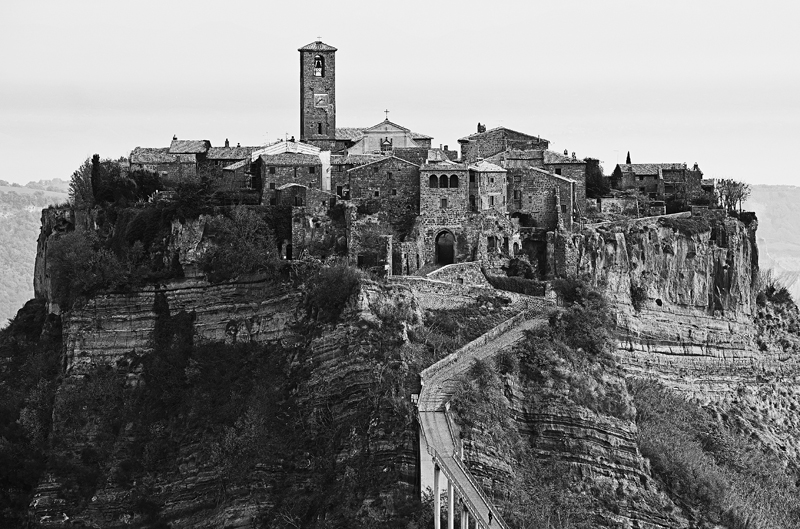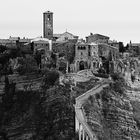CIVITA DI BAGNO REGIO, LA CITTA' CHE MUORE- BW
L'affascinante borgo medievale di Civita di Bagno Regio (VT), è noto in tutto il mondo come "la città che muore" per il progressivo crollo delle pareti perimetrali ed il conseguente abbandono da parte della popolazione nel corso degli ultimi secoli. Civita è raggiungibile attraverso un lungo e brutto ponte in cemento agibile soltanto a pedoni e motocicli; fra gli antichi edifici l'atmosfera che si respira è veramente surreale ed indimenticabile.
Al momento si sta assistendo a una progressiva rinascita del borgo; molti edifici sono stati restaurati e di altri è in corso il recupero, dopo che la popolazione dei residenti era scesa a numeri davvero microscopici. Il merito di tale risveglio è in parte da attribuirsi a personaggi del mondo dello spettacolo che vari anni fa "scoprirono" Civita.
Purtroppo l'effetto erosivo degli agenti atmosferici non s'arresta; uno studio condotto sulla velocità di arretramento dei bordi dei calanchi ha rilevato un'erosione media di circa 7 centimetri/anno.
People who've been there say "Civita" (chee-VEE-tah) with warmth and love. This precious chip of Italy, a traffic-free community with a grow-it-in-the-valley economy, has so far escaped the ravages of modernity. Please approach it with the same respect and sensitivity you would a dying relative, because — in a sense — that's Civita.
Civita teeters atop a pinnacle in a vast canyon ruled by wind and erosion.
The saddle that once connected Civita to its bigger and busier sister town, Bagnoregio (province of Viterbo), eroded away. Today a footbridge connects the two towns. A man with a Vespa does the same work his father did with a donkey — ferrying the town's goods up and down the umbilical bridge that connects Civita with a small, distant parking lot and the rest of Italy. Rome, just 60 miles to the south, is a world away.
Entering the town through a cut in the rock made by Etruscans 2,500 years ago, and heading under a 12th-century Romanesque arch, you feel history in the huge, smooth cobblestones. This was once the main Etruscan road leading to the Tiber Valley and Rome.
Inside the gate, the charms of Civita are subtle. Those looking for arcade tourism wouldn't know where to look. There are no lists of attractions, orientation tours, or museum hours. It's just Italy. Civita is an artist's dream, a town in the nude. Each lane and footpath holds a surprise. The warm stone walls glow, and each stairway is dessert to a sketch pad or camera.
Today, Civita's social pie has three slices: the aging, full-time residents; rich, big-city Italians who are slowly buying up the place for their country escape (a blue-blooded "Marchesa" owns the house next to the town gate — and Civita's first hot tub); and visitors enjoying la dolcezza di fare niente (the sweetness of doing nothing). Buoyed by my writing and exposure in German and French travel magazines, Civita can see up to 200 tourists a day on summer weekends. In summer, visit on a weekday.
(http://www.ricksteves.com/plan/destinations/italy/civitabd.htm)










Maria Grazia Bacino 22/12/2011 20:14
molto bella la foto, e interessante la didascalia.ciao
Maria Grazia
Emilio Sirletti 11/12/2011 18:54
Bellissima foto.Un bianconero che affascina con la sua perfetta leggibilità.
Bella ed esauriente la didascalia.
Buona serata, Emilio
Ladislaus Hoffner 08/12/2011 7:55
Einfach super gut gelungenes Foto im klassisschen s/w. Gratulation.Cattedrale Maria Santissima Assunta di Palermo
Ladislaus Hoffner